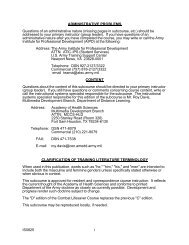MCWP-3-11.3-Scouting-and-Patrolling
MCWP-3-11.3-Scouting-and-Patrolling
MCWP-3-11.3-Scouting-and-Patrolling
Create successful ePaper yourself
Turn your PDF publications into a flip-book with our unique Google optimized e-Paper software.
13-6 _____________________________________________________________________________________________ <strong>MCWP</strong> 3-<strong>11.3</strong>Suitable Objective Rally PointAn easily located objective rally point is selected <strong>and</strong>made known to all patrol members. The objective rallypoint is located far enough from the ambush site sothat it will not be overrun if the enemy assaults theambush. Routes of withdrawal to the objective rallypoint are reconnoitered. Situation permitting, eachman walks the route he is to use <strong>and</strong> picks out checkpoints.When the ambush is to be executed at night,each man must be able to follow his route in the dark.After the ambush has been executed, <strong>and</strong> the search ofthe killing zone completed, the patrol is withdrawnquickly but quietly, on signal, to the objective rallypoint where it reorganizes for the return march. If theambush was not successful <strong>and</strong> the patrol is pursued,withdrawal may be by bounds. The last group mayarm mines, previously placed along the withdrawalroute, to further delay pursuit.Local SecuritySecurity must be maintained. Security elements do notusually participate in the initial attack, but protect therear <strong>and</strong> flanks, <strong>and</strong> cover the withdrawal.PatienceThe Marines of the ambush force must controlthemselves so that the ambush is not compromised.Patience <strong>and</strong> self-discipline are exercised by remainingstill <strong>and</strong> quiet while waiting for the target toappear, particularly if the patrol occupies the ambushsite well ahead of the arrival of the enemy. Patience isnecessary so as not to alert the enemy to the presenceof the ambush.SurpriseSurprise must be achieved, or the attack is not anambush. If complete surprise cannot be achieved, itmust be so nearly complete that the target is not awareof the ambush until too late for effective reaction.Surprise is achieved by careful planning, preparation,<strong>and</strong> execution so that targets are attacked when,where, <strong>and</strong> in a way for which they are least prepared.Coordinated FiresProperly timed <strong>and</strong> delivered fires contribute heavilyto the achievement of surprise, as well as to destructionof the enemy. The lifting or shifting of firesmust be equally precise; otherwise, the assault isdelayed <strong>and</strong> the enemy has an opportunity to recover<strong>and</strong> react. All weapons, mines, <strong>and</strong> demolitions arepositioned <strong>and</strong> all fires, including those of availableartillery <strong>and</strong> mortars, are coordinated to achieve thefollowing results:l Isolation of the killing zone to prevent the enemy’sescape or reinforcement.l Surprise delivery of a large volume of highly concentratedfires into the killing zone.ControlClose control of the patrol is maintained during movementto, occupation of, <strong>and</strong> withdrawal from theambush site. This is best achieved through rehearsals<strong>and</strong> establishment <strong>and</strong> maintenance of good communications.When the enemy approaches, the temptationto open fire before the signal is given is resisted.The patrol leader must effectively control all elementsof the ambush force. Control is most critical at thetime the enemy approaches the killing zone. Controlmeasures must provide for—l Early warning of enemy approach.l Fire control. Withhold fire until the enemy hasmoved into the killing zone, then open fire at theproper time.l Initiation of appropriate action, if the ambush isprematurely detected. Individual patrol membersmust be prepared to react if detected by the enemyprior to the initiation of the ambush.l Timely <strong>and</strong> orderly withdrawal of the ambush forcefrom the ambush site <strong>and</strong> movement to the objectiverally point.It is important to remember that an ambush patrolshould have four distinct signals: one to open fire(with an alternate signal to open fire to be used at thesame time as the primary); a signal to cease fire orshift fire; a signal to assault or search the killing zone;<strong>and</strong> a signal to withdraw. The signal to open fireshould meet two criteria: first, it should be the firing ofa weapon that will kill the enemy; secondly, it shouldbe a weapon reliable in any weather condition. A goodprimary signal is a Claymore mine, <strong>and</strong> an alternatesignal would be a closed bolt weapon (M16A2). Openbolt weapons (M240G, M249) should not be reliedupon to initiate an ambush.Execution of an AmbushThe manner in which the patrol executes an ambushdepends primarily on whether the ambush’s purpose is



